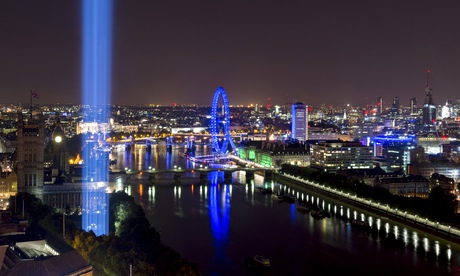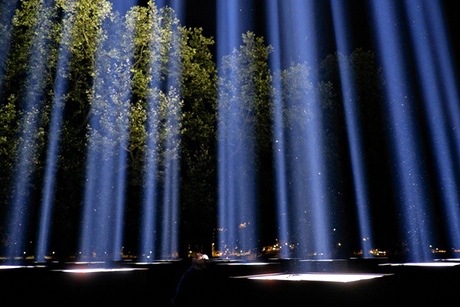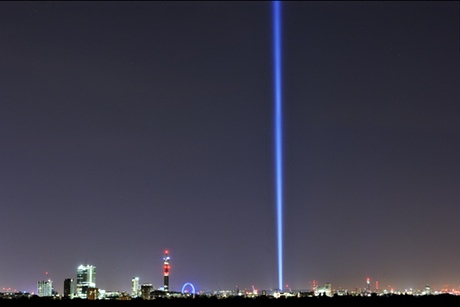Spectra: the dazzling column of light over London
After eight months of secrecy, a jaw-dropping pillar of light shot into the London sky last night to commemorate the first world war. Sean O'Hagan was given exclusive access to the artist and his artwork at the nerve-racking trial run

Ryoji Ikeda’s spectra shoots up into the London sky Photograph: William Eckersley
Last night, as darkness fell and the lights went out in businesses and households across Britain in remembrance of the outbreak of the first world war, a huge pillar of white light pierced the night sky above London, its brightness so intense that it could be seen over 12 miles away.
For those who happened to be passing Victoria Tower Gardens, a swath of green adjacent to the Houses of Parliament, the sense of wonder and disorientation was immediate and powerful, with the surrounding trees and buildings bathed in a glow emanating from the base of the pillar of light: a square of black matting on which 49 powerful spotlights beamed upwards as if into infinity.
The work, called spectra, is by Japanese sound and light artist Ryoji Ikeda, a quiet, self-contained young man whose vision is both minimalist and monumental. It's produced by the ever-adventurous Artangel, which brought you, among other projects, Rachel Whiteread's inside-out house in 1993, and Jem Finer's 1,000 year sound project, Longplayer, in 2000. Spectra was commissioned by the Mayor of London and 14-18 NOW(WW1 Centenary Art Commissions) as the centrepiece of its artistic commemoration of the start of the war. "The light spectra throws up into the night sky is a unifying point," says Boris Johnson. "It echoes how the first world war affected all Londoners, but also how they and the rest of the country came together, standing united during those dark days."
Spectra will appear from darkness to dawn over the next seven days, and people are encouraged to visit the site and interact with the project by walking though the grid of spotlights, arranged in seven rows of seven. Ikeda has also created an ambient soundtrack to enhance the experience: waves of subsonic sound punctuated by beeps and hisses, emanating from four sets of speakers pointing inwards towards the light. It's as if an alien craft is beaming down to a soundtrack by Brian Eno.
The 15km-high tower of light is the culmination of eight months of preparation and secrecy. When I was told about it a month ago, I joined an elect group that included Artangel, the artist and his crew, as well as the mayor and select members of the House of Lords and the Royal Parks. "It is different to anything else we have commissioned on two counts," Artangel's co-directer, Michael Morris, explained as I walked around the site with him and Ikeda last week, while men in luminous jackets laid cables and fretted about the hot sunlight expanding the black matting beneath our feet. "It is a work that will announce itself without any of the usual PR fanfare," he added, "and it is a work that already exists, insofar as it has been staged in various forms in several cities including Barcelona and Amsterdam. But this time, the context is very different because of the centenary of the first world war. My sense is that, on the first few nights, there will be a sense of reverence at the site. But then, as the numbers of people increase towards the weekend, it will no doubt take on a life of its own."
 Ryoji Ikeda's Spectra being tested in Victoria Tower Gardens, London. Photograph: Frantzesco Kangaris for The Guardian
Ryoji Ikeda's Spectra being tested in Victoria Tower Gardens, London. Photograph: Frantzesco Kangaris for The Guardian
Ikeda, who exudes a focused calm throughout the preparations, nods. "When you experience it," he says, "any kind of context is suddenly gone. From a distance, it looks monumental and solid, but when you are in it, it is entirely meditative. People stare up in wonder. It causes necks to strain. The experience is so pure and direct, they can take it with them into their own life." Or project their own imaginings on to it – as when it was shown in Barcelona and hundreds of people phoned the police in a panic. "They were convinced it was a UFO landing," says Ikeda, grinning, "or a light from heaven."
I visited the site again just before midnight on Sunday, when Ikeda and his technical crew had gathered for a rehearsal: a 10-minute trial run in which each spotlight was switched on and focused individually. For Morris and his Artangel co-director James Lingwood, who had brought along the British artist Jeremy Deller, this was the most nerve-wracking moment of the entire project, not just because of the very real possibility of a technical hitch, but also the threat of a surge of social-media interest prompted by passersby with their smartphones and Instagram accounts.
"There is no way around it," Ikeda told me calmly. "It has to be tested, and it will take whatever time it takes to make the necessary adjustments. This is usually one minute per spotlight." Morris nodded nervously. "That's 49 minutes, Ryoji," he said. "Ten would be much better." So, just after midnight, the security light that had glared over the site, making the rows of encased spotlights look like metal gravestones, was turned off. As our eyes adjusted and two figures moved around the grid, the beams appeared one by one, then row by row, shooting silently up into the sky to a collective exhalation of breath. Ten minutes was all it took.
Tentatively, I wandered through the grid, while ominous waves of sound washed over me. It felt threatening at first, but then, as I surrendered to the immersive nature of the project, oddly calming. The first thing you realise is that, for such a static, minimal piece, spectra is a living, constantly changing entity: dramatic and subtle, geometric and shape-shifting, opaque and yet somehow solid. Standing close to the middle, I looked up, and all 49 pillars of light seemed to converge at a point somewhere high above my head. Just how high was impossible to tell – distance, like perspective, is distorted. A few steps sideways and the geometric pattern shifted and lost its symmetry. Positioning myself at a corner, I looked up at what seemed to be a single wall of whiter light that split the grid diagonally. On cue, a splat and hiss of shrill sound suggested a fissure of some kind.
The further back you go from the base, the taller and more solid it seems, as the thin beams become one. Across London, on elevated points like Primrose Hill or Crystal Palace, it looks like one single shaft of white light touching infinity somewhere high above the earth – one can only sense its epic reach on a cloudless night. A few minutes into the trial, spectra came alive in an entirely different way as moths and flies flickered in and out of the light, and condensation rose off the spotlights like dry ice. "A bit Pink Floyd, that," said Deller. One can indeed imagine devotees of Meddle-era Floyd making a deep connection with the ambient soundtrack and flickering towers of light.
 A long-distance view of Spectra. Photograph: William Eckersley
A long-distance view of Spectra. Photograph: William Eckersley
The history and logistics of spectra are intriguing. In Paris in 2008, it comprised a grid of 64 spotlights; in Amsterdam that same year, 25 spotlights pierced the sky at four different sites; in Buenos Aires in 2012, it took the form of a 100m-long linear projection. Ikeda has now settled on the 7x7 formation, which requires a crew of about 30 technicians, many from the Paris-based Skylight company, who designed and installed the spotlights that illuminate the Eiffel tower. It runs off four generators fuelled by biodiesel and, according to Ikeda, "each spotlight is four kilowatts, so over the seven days, its total energy consumption will be equivalent to 10 to 20 households."
For the next seven nights, spectra will become possibly the single most-viewed work of conceptual art ever, given that it will be hard for anyone living in London not to see it. And, as the weather changes, so will the nature of the light. "I would kind of like it to rain," says Ikeda, "because then the rainbows will appear inside it – and people like that." If it were to rain heavily, he adds, "it will become a bit more Blade Runner – needles of rain like steel falling upwards. Nature is visible all the time in the work. That is spectra's real power."
Last night, though, its power was more sombre: a vast tower of light pointing to the heavens in contrast to the single flickering candle left burning on the Tomb of the Unknown Soldier in Westminster Abbey. The humble and the monumental, each in their own way, encouraging a sense of reflection and reminding us of that dark moment 100 years ago when, as the British foreign secretary Edward Grey famously remarked: "The lamps are going out all over Europe – we shall not see them lit again in our lifetime."
沒有留言:
張貼留言